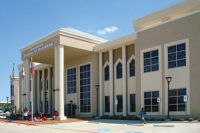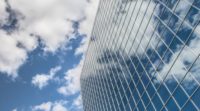In this article, learn about Casa Bella Verde's unique features:
- an effective and aesthetically pleasing water conservation system
- full integration of insulated concrete forms (ICF)
- worldwide media attention
The American dream is alive and well. At least that should be the point of view of Briana Alhadeff, project manager, designer, builder and owner of Casa Bella Verde. This more than 9,000-square-foot home, constructed in El Dorado Hills, Calif., is of modern, innovative construction in the hills of Steinbeck land. A whopping 27,663 square feet of IntegraSpec ICF wall systems and 18,000 square feet of Insul-Deck Roof and Floor Systems were used on this project.
Alhadeff’s passion is sustainability and green design, so it was no surprise when it came to designing her dream home that these principles would be put to practice. Her day job is assisting builders and construction professionals in sustainability and green design.
“Because builders do not have the time to do the years of research that I have accrued in the area of sustainable design, they will come to me to assist them in this area so that they may provide their clients with green options,” Alhadeff says. “Since I have started my business, I have seen tremendous growth in the area of green building,” she says. “When the cost of energy was low, people did not seem to have an interest in green and sustainable design, but as soon as energy costs began to skyrocket, that is when people took notice and started looking for more energy-efficient options like solar power and ICF walls and floors for the construction of their homes.”
A Room with a View
Perched on the highest peak in the area, the 40-acre parcel serving as the site for Casa Bella Verde offers a 360-degree view. Surrounded by water and picturesque views, landmarks such as the Sierra Nevada mountain range, Lake Tahoe, Folsom Lake and the foothills of the Napa Valley can all be seen. The main house is approximately 7,500 square feet, including a 1,500-square-foot guest house connected by a sky bridge. An infinity edge pool also wraps around half of the home, so no matter where you are standing, water is always visible.
What has really captured the attention of the building community is the fact that the home is sustainable despite its size. Alhadeff opted to go with ICFs in order to help the project achieve the goal of LEED Platinum. The forms used have insulating properties which perform at an R-value of 50.
Other green features are a geothermal system tied into a radiant floor heating system and 95 solar panels on the roof, which will supply the home with most of the energy it will require. Also attached to the roof is a vertical axis wind turbine. The house will include an onsite water treatment facility, which is set up like a small municipal system.
“Every drop of water that enters the house will be used twice, once for bathing, washing dishes, etc., then treated and used again for irrigating the plants throughout the property. The house also has an 80,000-gallon cistern for rainwater harvesting, which will be used for irrigating the rooftop garden and replacing the evaporative loss from the swimming pool,” says Alhadeff. “In addition to creating a self-sustaining house, we are also incorporating complete home automation and control into the design, which will include touchscreen technology to control lighting, security, A/V and all of the home’s heating and cooling, just to name a few. Incorporating home automation and controls into the design of the home was a must for this house. When your home is controlled, it not only gives you a better quality of life, it makes your house more energy efficient.
“For example,” she continues, “All of our window openings are wired for the shades to raise and lower automatically. To achieve this, we installed light sensors on the east and west facing exterior walls of the house. We will be able to program our system to raise and lower the shades automatically when a certain amount of light is received by these sensors. The house, in turn, will be cooler in the summer, reducing the energy consumption of the house and therefore lowering my energy bill.” Alhadeff’s ultimate goal is to achieve net zero, which would eliminate an energy bill altogether. “This, combined with the other systems in the house, will make Casa Bella Verde completely self-sustaining,” she says. “A smart house that is completely self-sustaining, energy efficient and beautiful.”
ICF Inspired
Although not a licensed architect, Alhadeff did design the home. With assistance from IntegraSpec’s Nicholas Nikiforuk, Alhadeff’s drafting was fleshed out into CAD to obtain the permits for building. (Nikiforuk has an architecture, engineering and ICF building background, in addition to Alhadeff’s interior design and project management background.)
The duo used the Casa Bella Verde project as a training site for licensed contractors to work and receive training in the area of ICF construction. Although this added time to the construction schedule, Alhadeff says she enjoyed introducing builders to new technology.
“Because I built with ICFs, it made all of the beautiful cantilevers possible without the need for expensive steel I-beams and cranes,” she says, adding that ICFs were used for several reasons.
On the top of the list, she says that ICFs are known for their energy-efficient properties. “You have 2½ inches of EPS on the outside and inside of your steel-reinforced, solid concrete wall. You just can’t get a stronger, more energy-efficient structure than that.” The material has strong fire-resistive properties, will never burn and is resilient to tornadoes hurricanes, earthquakes, floods and termites.
“It is a house that will last for more than 1,000 years,” Alhadeff says. “I call Casa Bella Verde the millennium house…that is why I buried a time capsule. When this house is eventually demolished (because it certainly will not go down from natural causes), I want people to know a little bit about what life was like at this time and why I built this house.”
During the design phase, Alhadeff researched all ICF options and found that IntegraSpec best suited her ambitions. She saw the systems at an International Builders’ Show and was impressed with staff’s knowledge and ideas central to design capabilities with the material.
“I knew the product was great, but it was not until our first wall pour that I knew that I made the right decision,” she says. “We poured our 230-foot-long, 18-foot-high cistern wall in one lift. We had absolutely no trouble at all and not one blow out. There’s no way we could have done this with any other system.”
Because no project of this size is easy, a few challenges needed to be overcome. “For the construction of the pool, we needed to create a waterproof shell. To achieve this, we made the walls and floor of the pool monolithic by pouring them at the same time,” she says. “The strength and design of the IntegraSpec system allowed us to accomplish this. This would have created issues had we built conventionally. In addition, the ICF technology allowed us to easily form the Caribbean shelf, the spa, the pedestal steps and the steps leading into the pool. This would have been a challenge with conventional forming.”
The building team eliminated several columns and post supports by using the ICF flooring system. In addition, the team achieved 40- to 70-foot cantilevers easily with the flooring system that would have been extremely difficult to accomplish with conventional hinge systems. These cantilevers were achieved using a special waffle grid technique that creates beams that run in both directions like a waffle. The concrete is then poured to create a monolithic floor.
Show and Tell
According to Alhadeff, her business is booming as a sustainable building consultant. With her knowledge and experience in green building—and the media focus on Casa Bella Verde—the company is getting calls and visitors from around the world. Architects, engineers and builders have come to tour the project and learn more about the technologies used.
“They see how an ICF home is constructed and feel the insulating properties immediately upon entering the home,” says Alhadeff. “We show them all the green features of the house and explain how all the systems are integrated to create the ultimate green and sustainable home.”
ICF homes are worth the initial investment to have a house that can last forever, Alhadeff concludes. “With an ICF home, they will always have peace of mind knowing that they will never lose their home to a natural disaster.”







